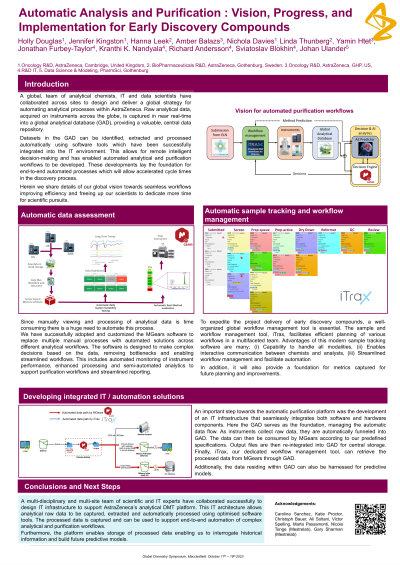Frontiers in Technology
Poster Session B
(1017-B) Automating Analytical Workflows in Drug Discovery
Wednesday, May 29, 2024
10:30 - 11:15 CEST
Location: Exhibit Hall


Holly Douglas
Senior Research Scientist
AstraZeneca
CAMBRIDGE, England, United Kingdom
Poster Presenter(s)
Abstract: AstraZeneca’s analytical teams analyse and purify thousands of samples every year, using diverse and complex workflows. Our drive to identify and remove process bottlenecks and improve efficiency encompasses both hardware investment and software development. Herein, we describe three key elements which combine to deliver significant increases in laboratory capacity; automated data processing, an intelligent sample tracking platform and state-of-the art sample handling hardware.
As part of our purification workflows, huge amounts of analytical screening data are generated. Integrated automatic processing software reduces the burden of reviewing this data and eliminates a major bottleneck to sample progression. The decision-making algorithm within the software identifies the best chromatographic conditions for purification, thus streamlining the workflow and increasing laboratory capacity. Additionally, the results are exported to a global database for future development of machine learning algorithms for prediction of optimised purification conditions, eliminating the need for screening altogether.
Additionally, we have developed an intelligent sample management platform that utilises real-time Kanban visualisation to track samples through multiple analytical workflows. Features such as sample batching and automated report generation enable streamlined workflows. Furthermore, automated run list creation and datafile upload and integrations to established AZ software ensure a high level of data integrity and traceability. In addition, data from the sample tracking platform can be interrogated and exported to a Power BI dashboard allowing KPIs to be monitored and data trends plotted to optimise resource and equipment management.
Finally, investment in a state-of-the-art robotic platform has fully automated the reformatting and QC analysis of final compounds, further increasing laboratory capacity. This system relieves analysts of time-consuming manual tasks, allowing more time for complex analyses as well as significantly improving data quality. Barcode scanning and location mapping by the robot’s software allows samples to be tracked throughout the process and sample data is exported directly to the sample tracking platform discussed above as part of an end-to-end data flow.
Identifying and automating process bottlenecks, removing repetitive sample processing steps and enabling sample and data tracking has enabled us to develop stream-lined and efficient analytical workflows. Sample throughput and lab capacity has been increased significantly, allowing more compounds to pass through the DMTA cycle than ever before.
As part of our purification workflows, huge amounts of analytical screening data are generated. Integrated automatic processing software reduces the burden of reviewing this data and eliminates a major bottleneck to sample progression. The decision-making algorithm within the software identifies the best chromatographic conditions for purification, thus streamlining the workflow and increasing laboratory capacity. Additionally, the results are exported to a global database for future development of machine learning algorithms for prediction of optimised purification conditions, eliminating the need for screening altogether.
Additionally, we have developed an intelligent sample management platform that utilises real-time Kanban visualisation to track samples through multiple analytical workflows. Features such as sample batching and automated report generation enable streamlined workflows. Furthermore, automated run list creation and datafile upload and integrations to established AZ software ensure a high level of data integrity and traceability. In addition, data from the sample tracking platform can be interrogated and exported to a Power BI dashboard allowing KPIs to be monitored and data trends plotted to optimise resource and equipment management.
Finally, investment in a state-of-the-art robotic platform has fully automated the reformatting and QC analysis of final compounds, further increasing laboratory capacity. This system relieves analysts of time-consuming manual tasks, allowing more time for complex analyses as well as significantly improving data quality. Barcode scanning and location mapping by the robot’s software allows samples to be tracked throughout the process and sample data is exported directly to the sample tracking platform discussed above as part of an end-to-end data flow.
Identifying and automating process bottlenecks, removing repetitive sample processing steps and enabling sample and data tracking has enabled us to develop stream-lined and efficient analytical workflows. Sample throughput and lab capacity has been increased significantly, allowing more compounds to pass through the DMTA cycle than ever before.
